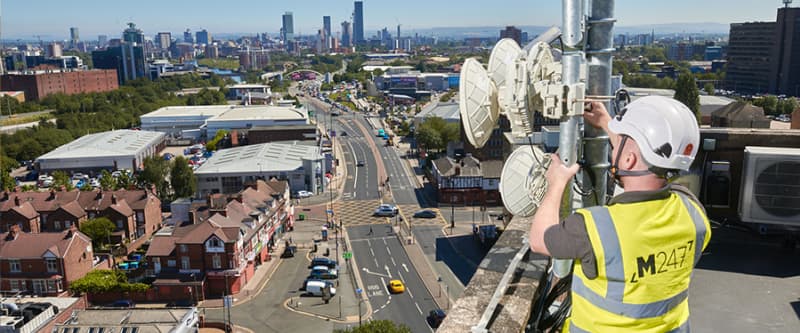The COVID-19 pandemic has resulted in the large scale move of employees to work remotely. For business continuity, it’s vital for businesses to ensure networks have enough capacity to deal with an increase in inbound traffic as workers attempt to access office and cloud-based applications from home to carry on performing their roles. For many, this requires an upgrade in their business bandwidth, but with long delays on fibre installation lead times, wireless leased lines are stepping up to provide a very valid, alternative option. Here’s why…
The immediate need to increase bandwidth for business continuity
With most or all of their employees working from home, businesses need to ensure their teams can access all the network-based applications to continue to work effectively. That means being able to guarantee enough capacity so that any services which run from the premises or in the Cloud are able to handle this increased level of inbound traffic.
The cost to businesses of being offline, even for an hour, during the COVID-19 pandemic is huge. Imagine the impact of not being able to access files, update critical databases such as Salesforce, send customer emails via our CRM system or communicate and collaborate internally via applications like Microsoft Teams or your intranet.
As a result, businesses that have previously provided more than adequate access, now need to upgrade. For example, a business with MPLS might usually use only 100Mbps of internet breakout if they predominantly use the site-to-site connectivity for office-based working. But with their entire workforce based at home and trying to connect to internal systems all at once, that 100Mb is unlikely to be enough to cope with the additional inbound traffic. The need to increase bandwidth – and quickly – is understandable.
A delay in fibre leased line installations
Openreach halted any non-critical installations in April and, even with a recent decision to start to relax this, will result in a large back-log, and businesses can now expect a significant increase in the average time to install a fibre leased line. With this situation likely to cause an issue for months, it is not really feasible to wait the usual 30-90 days (or more) for a fibre connection to be installed. Businesses need to get additional bandwidth in place quickly to ensure their employees and business itself stay productive, efficient and don’t suffer any downtime.
Businesses find themselves looking to alternatives to ensure business-grade internet connectivity and resilience for their networks – and wireless leased lines are providing that solution.
What is a wireless leased line and how does it fair against fibre?
Wireless leased lines can compete with fibre on every level in terms of provision, offering high-speed (from 10Mbps up to 10Gbps), business-grade internet connections with uncontended bandwidth and low latency. And in terms of cost and speed-of-installation, they are a great solution for businesses seeking increased capacity both quickly and affordably.
The very nature of the connection – which uses advanced radio and microwave technology rather than underground cables – means businesses can react quickly to their current needs, increasing bandwidth within days and maintaining connectivity when they need it the most. Read more in our wireless leased lines explained blog.
Wireless leased lines are a fast, simple, cost-effective way of ensuring your remote users have uninterrupted access to their business-critical applications whenever they need it.
- Business grade connectivity: high-speed (from 10Mbps up to 10Gbps), business-grade internet connections that are uncontended with low latency
- Cost effective: cheaper to install, upgrade and maintain than fibre
- Fast installation: simple installation with no digging up of roads, planning applications, or laying down of cables required installation is usually completed within 25 working days (but as fast as five)
- Easy to upgrade: Need more bandwidth? This can be done quickly and easily, usually remotely the same day.
How does wireless work?
A wireless leased line uses rooftop antennae to provide a point-to-point (P2P) connection to the network. Instead of reaching out to your internet supplier and asking them to dig up the road and supply a cable to your office, your ISP will install an antenna and line it up with others in the area so a P2P connection can be directed at your building. As long as your office has a clear line of sight (LOS) to the connection route, and that the appropriate surveys and landlord approvals have been given, there is nothing else to it – your wireless connection can be installed or scaled up in a matter of days.
A hybrid solution for true business resilience
Connectivity does not need to be an all or nothing solution. Wireless will work in harmony with your existing fibre connection to provide complete resiliency. Increase your bandwidth with wireless or use it as a failsafe for those times of increased demand on the fibre network, and you’ll put your business in the best position to weather any connectivity storms. Having a connection through the air, as well as under the ground, is one of the best ways of ensuring true resiliency for your network, as well as peace of mind for your teams.
Keeping you connected– installations as fast a 5 working days*
To find out more about M247’s wireless leased line services, visit our leased lines pages. Or to discuss your requirements with one of our team, contact us today.
*subject to surveys and landlord approvals




